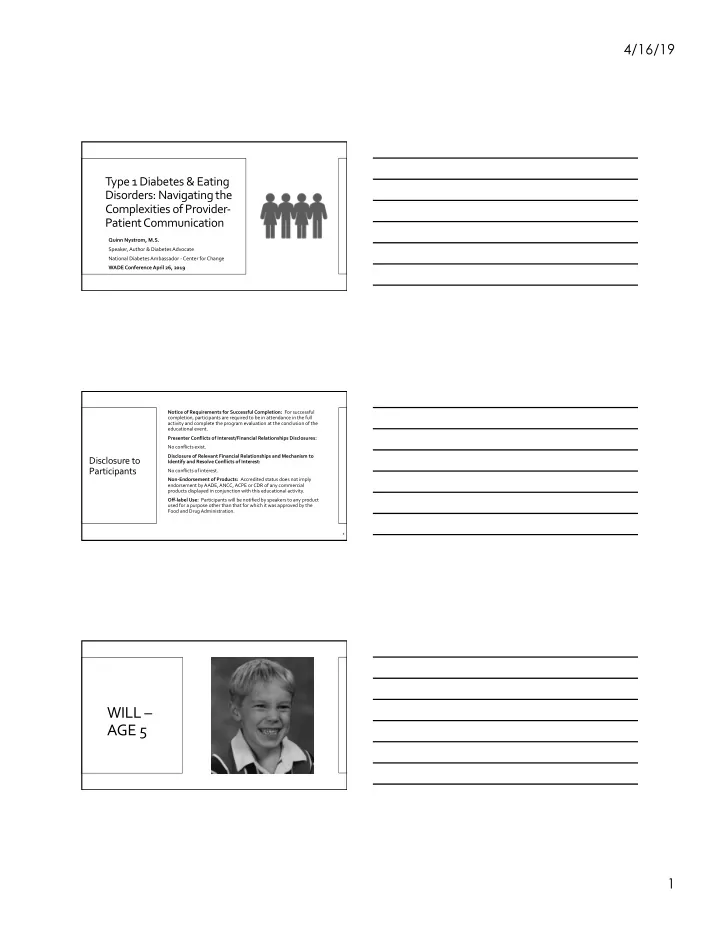

4/16/19 Type 1 Diabetes & Eating Disorders: Navigating the Complexities of Provider- Patient Communication Quinn Nystrom, M.S. Speaker, Author & Diabetes Advocate National Diabetes Ambassador - Center for Change WADE Conference April 26, 2019 Notice of Requirements for Successful Completion: For successful completion, participants are required to be in attendance in the full activity and complete the program evaluation at the conclusion of the educational event. Presenter Conflicts of Interest/Financial Relationships Disclosures: No conflicts exist. Disclosure of Relevant Financial Relationships and Mechanism to Disclosure to Identify and Resolve Conflicts of Interest: Participants No conflicts of interest. Non-Endorsement of Products: Accredited status does not imply endorsement by AADE, ANCC, ACPE or CDR of any commercial products displayed in conjunction with this educational activity. Off-label Use: Participants will be notified by speakers to any product used for a purpose other than that for which it was approved by the Food and Drug Administration. 2 WILL – AGE 5 1
4/16/19 AGE 13 -Blood glucose meter -Blood glucose test strips -Ketone strips -Lancing device -Lancets -Continuous Glucose Monitor & Sensor -Alcohol swabs -Syringes -Insulin pump supplies -Batteries -Glucose tablets -Glucagon kit -Waterproof tape -Adhesive remover -Frio cooling wallet -Snacks 2
4/16/19 8 Camp Needlepoint 3
4/16/19 National Youth Advocate 10 Other reality… 4
4/16/19 5
4/16/19 6
4/16/19 The dual diagnosis of an eating disorder and type 1 diabetes is often referred to as “diabulimia,” however this is not a medically recognized term and it is not an accurate description. What is ED- “Among some academics, the nomenclature eating DMT1? disorders in diabetes mellitus type 1 (ED-DMT1) is used to denote the spectrum of disturbed eating behavior found within this specific demographic.” –Jacqueline Allen, Birkbeck University 7
4/16/19 75% of American women are dissatisfied with their appearance. Pr Prevalenc alence e 50% of 9 year old girls and 80% of 10 year old girls of of E Eating have dieted. Diso Disorder ders s At least 4% of teenage girls and college-age women become anorexic or bulimic. Steinhausen HC: The outcome of Anorexia Nervosa in the 20 th century. Am J Psychiatry 159:1284-1293,2002. Anorexia Nervosa and Bulimia Nervosa- Diagnosis & Treatment Guide for Professionals. • ED behaviors seen in 8% of T1DM vs 1% of peers without DM. • Increased risk of disturbed eating behavior in girls with T1DM as young as 9. • 32.4% of females with type 1 diabetes have Ea Eating some form of disordered eating or weight control behavior. Disorders + + • 36% reported intentional omission of insulin. Diabetes Diabe es • Strong association between type 2 diabetes and clinically significant binge eating. Colton P et al, Eating disorders in girls and women with type 1 diabetes: A longitudinal study of prevalence, onset, remission and recurrence. Diabetes Care 38:1212-1217,July 2015 Peveler RC. Type 1 Diabetes & Eating Disorders, Diabetes Care 2005 Colton P. et al, Disturbed eating behavior and eating disorders in preteen and early teenage girls with type 1 diabetes; a case-controlled study Diabetes Care 27:1654-1659, 2004 Udo et al. Menopause and metabolic syndrome in obese individuals with binge eating disorder. Eat Behav 2014;15 Feels betrayed by Emphasis on food body with diagnosis and dietary restraint. of diabetes. Diabetes Society setting “food management focuses rules” for people with on numbers. diabetes. • Patient judges self being "good" or "bad" based on Why Wh y eating patterns or blood glucose level. Weight gain/higher Belief that you “ate higher highe r BMI, result from your way into intensive insulin diabetes”. therapy. risk? risk? Temptation factor Effect of diabetes on • Easy availability of self-concept, body deliberate insulin omission image, and family to control weight. interactions. Family dynamics involving autonomy and independence concerning diabetes self-management. Diabetes Spectrum volume 22, Number 3,138-141,160, 2009. Mitchell, J. Medical comorbidity and medical complications associated with Binge- eating disorder. Int J Eat Dis 49:3. 8
Recommend
More recommend